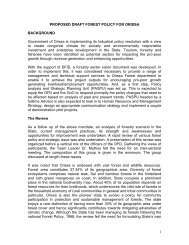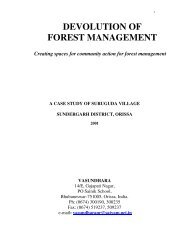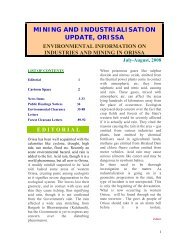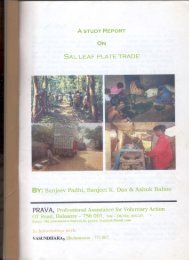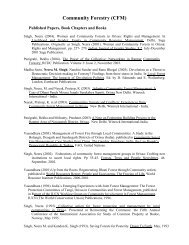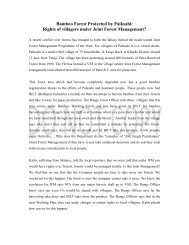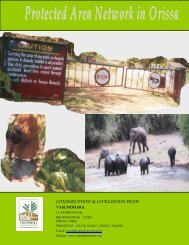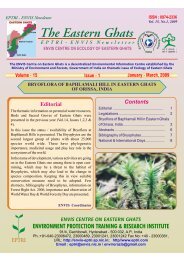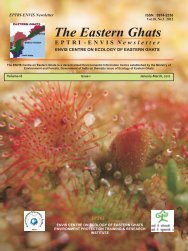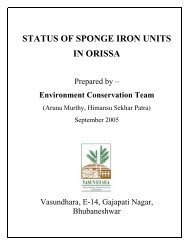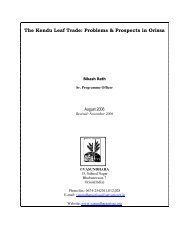Bamboo in Orissa: Trade and Livelihood Perspective - Vasundhara
Bamboo in Orissa: Trade and Livelihood Perspective - Vasundhara
Bamboo in Orissa: Trade and Livelihood Perspective - Vasundhara
Create successful ePaper yourself
Turn your PDF publications into a flip-book with our unique Google optimized e-Paper software.
All rights reserved by VASUNDHARA(www.vasundharaorissa.org). For any clarification, contact author at sunlit1968@yahoo.co.<strong>in</strong><br />
The f<strong>in</strong>ancial benefit of nationalisation was remarkable. While bamboo contributed to the<br />
forest revenue 7.9%, 5.8% <strong>and</strong> 4.4% <strong>in</strong> 1985-86, 1986-87 <strong>and</strong> 1987-88 respectively; <strong>in</strong><br />
1988-89 the contribution rose to 9.1% <strong>and</strong> then to 14.7%(highest) <strong>in</strong> 1995-96(Saxena N.C.<br />
2003 , Government Policy for NTFPs <strong>in</strong> <strong>Orissa</strong>, p.5).<br />
S<strong>in</strong>ce nationalisation of the product repealed the scope of any specific privilege of the<br />
artisans, they were no longer allowed to get permits for cutt<strong>in</strong>g bamboo for their use.<br />
However, as clarified by the Pr<strong>in</strong>cipal Chief Conservator of Forests <strong>in</strong> 1989, the artisans<br />
can purchase bamboo from the OFDC depot at the rate fixed/regulated <strong>in</strong>/by the Supply of<br />
<strong>Bamboo</strong>s to Artisans <strong>in</strong>clud<strong>in</strong>g Co-operative Societies (<strong>Orissa</strong>) Rules,1980 (Pathak A.K.,<br />
op.cit.). Rule 5 of the said Rules specifies the value of salia bamboo as 43 paise per piece,<br />
i.e., Rs.43/- per 100. The advantage of this post-nationalisation provision is that earlier the<br />
artisans had to pay the same price even though they themselves put their labour for cutt<strong>in</strong>g<br />
<strong>and</strong> removal of the bamboo from forest whereas now they do not need to <strong>in</strong>vest their labour<br />
<strong>in</strong> cutt<strong>in</strong>g <strong>and</strong> removal of bamboo <strong>in</strong> the forest <strong>and</strong> OFDC would supply their raw material<br />
at no additional cost. However, the disadvantage is that what OFDC supplies is often the<br />
mature bamboo whereas the artisans require green bamboo for their work; hence the OFDC<br />
supply can hardly be of their use 3 . Also, there is no guarantee that the nearest OFDC depot<br />
will be able to fulfil their annual requirement even as per the limit(540 pieces) fixed <strong>in</strong> the<br />
1980 Rules, because supply to Paper Mills was the Corporation's priority.<br />
In May 1990 the government issued another letter to the effect that <strong>in</strong> the nistar-pay<strong>in</strong>g<br />
areas, at least one bamboo depot was to be opened <strong>in</strong> each bamboo coupe so as to sale salia<br />
long bamboo(th<strong>in</strong>) to the tenants @Rs.1.50 per piece, <strong>and</strong> that each tenant would be<br />
supplied 50 bamboos per annum on 'first come, first serve' basis 'subject to availability'.<br />
The loss on account of this concession was to be recouped by a correspond<strong>in</strong>g <strong>in</strong>crease <strong>in</strong><br />
the rate of bamboos <strong>in</strong> the non-ex-coupe depots (Pathak A.K., op.cit.).<br />
Violation of policy decisions:<br />
As per the Forest Conservation Act,1980 forests can not be leased out to private parties<br />
without the permission of the Govt of India. The Govt of <strong>Orissa</strong> violated this provision by<br />
giv<strong>in</strong>g leases to the paper mills without the prior approval of the GoI (Saxena N.C. 2003 ,<br />
Government Policy for NTFPs <strong>in</strong> <strong>Orissa</strong>, p.14).<br />
Earlier, the paper mills, as lessees, used their own resources(manpower, etc.) to exploit the<br />
bamboo forests as per their need. After nationalisation, they lost the power to utilise the<br />
bamboo forests <strong>in</strong> their own way. By 1992-93, the shortfall <strong>in</strong> average annual production<br />
dur<strong>in</strong>g the post-nationalisation period was about 1.5 lakh SUs as compared to the average<br />
annual production dur<strong>in</strong>g the pre-nationalisation period, <strong>and</strong> the mills, while express<strong>in</strong>g<br />
their concern over this trend of decreas<strong>in</strong>g production level <strong>and</strong> deteriorat<strong>in</strong>g quality under<br />
OFDC’s tenure, requested the govt to review the policy(Sharda A.K., <strong>Bamboo</strong> <strong>in</strong> <strong>Orissa</strong>: A<br />
Resource Forgotten, paper presented at a workshop organised at Bhubaneswar <strong>in</strong> April<br />
3 An officer(name withheld) clarified that the bamboo harvested by OFDC could be used by the artisans<br />
when supplied fresh, but because of various operational constra<strong>in</strong>ts sometimes it takes a lot of time to take<br />
the harvest to the depots which deteriorates the quality.<br />
14



